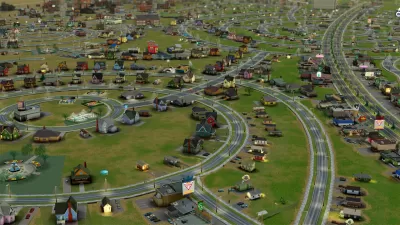The video game has inspired many people to pursue careers in planning. But, the newest version is also trying to better align the simulations with what planners face in the real world.

Jessica Roy writes about the history and influence of SimCity, the urban planning simulation game first released in 1989:
For many urban and transit planners, architects, government officials and activists, "SimCity" was their first taste of running a city. It was the first time they realized that neighborhoods, towns and cities were things that were planned, and that it was someone's job to decide where streets, schools, bus stops and stores were supposed to go.
While SimCity lead many planners into the field, the game has been criticized for creating worlds that do not reflect reality. The cities do not have bike lanes or mixed-use developments and, in the past, did not have parking. In addition, the options and solutions are oversimplified, say critics. "To lower crime rates, build police stations. If people complain about traffic, build more roads. If you need space to build a freeway or a stadium, raze working-class neighborhoods," says Roy.
The most recent iteration, an app called "SimCity: BuildIt" released in 2014, tries to address some of the limitations of earlier versions. The architecture and topography are more diverse, and some of the buildings include visible parking. "You can play a 'Green City' map in which residents have urban gardens and there's less pollution. Solar power is now an option," notes Roy.
FULL STORY: From video game to day job: How ‘SimCity’ inspired a generation of city planners

Alabama: Trump Terminates Settlements for Black Communities Harmed By Raw Sewage
Trump deemed the landmark civil rights agreement “illegal DEI and environmental justice policy.”

Planetizen Federal Action Tracker
A weekly monitor of how Trump’s orders and actions are impacting planners and planning in America.

The 120 Year Old Tiny Home Villages That Sheltered San Francisco’s Earthquake Refugees
More than a century ago, San Francisco mobilized to house thousands of residents displaced by the 1906 earthquake. Could their strategy offer a model for the present?

Rural Missouri Transit Service Could Lose State Funding
OATS Transit offers low-cost rides to primarily elderly rural residents with little or no access to other transportation options.

Opinion: California’s SB 79 Would Improve Housing Affordability and Transit Access
A proposed bill would legalize transit-oriented development statewide.

Record Temperatures Prompt Push for Environmental Justice Bills
Nevada legislators are proposing laws that would mandate heat mitigation measures to protect residents from the impacts of extreme heat.
Urban Design for Planners 1: Software Tools
This six-course series explores essential urban design concepts using open source software and equips planners with the tools they need to participate fully in the urban design process.
Planning for Universal Design
Learn the tools for implementing Universal Design in planning regulations.
Clanton & Associates, Inc.
Jessamine County Fiscal Court
Institute for Housing and Urban Development Studies (IHS)
City of Grandview
Harvard GSD Executive Education
Toledo-Lucas County Plan Commissions
Salt Lake City
NYU Wagner Graduate School of Public Service





























